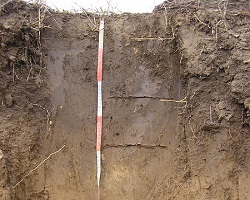Giving Grasslands a Close-up
Drive past a grassland, and from your car window it may seem a boring, unbroken sea of grass. However, if you walk into it and sit down in five different spots, you'll find that not one of them looks the same. These small areas that are different from the rest of the grassland are called microhabitats.

Microhabitats can change what kind of animals and plants live in a grassland. For instance, a lizard that likes to sun itself may do better in a grassland with patches of bare ground or rocks than a grassland completely carpeted in grass.
Small areas of bushes or trees give birds places to nest. Low-lying areas may turn to wet-lands for part of the year and provide breeding grounds for frogs and toads.
If the grassland has hills, plants that don’t need much water may grow on the slopes while water-loving plants grow at the bottom where they can collect run-off (water that comes from the slopes).
The next time you see a grassy area, look and see if you can find any microhabitats and guess what kind of animals would use them.Underground

Grasslands aren’t just defined by all the grass, plants and animals you see on the surface above the ground. If you cut into the side of a grassland hill, you'd find a lot more than dirt.
Underground, a grassland is riddled with burrows, tangled with roots, and crowded with worms and insects that rarely come up to see the sun. There are even things you can't see with your naked eye: bacteria that help break dead things down into nutrients other plants can absorb from the soil, and special fungus that lives in the roots of plants.
A Dirty Business

Grasslands usually have very rich, dark dirt (also known as topsoil) and a lot of it. If you've ever pulled up a clump of grass, you've seen that they have lots of roots; sometimes there's almost as much of the plant underground as above it. These roots go many feet into the dirt.
When a clump of grass dies aboveground, its roots belowground die too. When the roots die, they begin to break down into nutrients that other plants can use, a process called decomposition. All those roots breaking down helps make rich soil, which is dirt that is high in nutrients and can support a lot of plants.
Images via Wikimedia commons. Buffalo gap grasslands image via Chris Light.
Read more about: Grasping Grasslands
Bibliographic details:
- Article: Anatomy of the Grassland
- Author(s): Dr. Biology
- Publisher: Arizona State University School of Life Sciences Ask A Biologist
- Site name: ASU - Ask A Biologist
- Date published: 1 Mar, 2014
- Date accessed:
- Link: https://askabiologist.asu.edu/anatomy-grassland
APA Style
Dr. Biology. (Sat, 03/01/2014 - 17:11). Anatomy of the Grassland. ASU - Ask A Biologist. Retrieved from https://askabiologist.asu.edu/anatomy-grassland
Chicago Manual of Style
Dr. Biology. "Anatomy of the Grassland". ASU - Ask A Biologist. 01 Mar 2014. https://askabiologist.asu.edu/anatomy-grassland
Dr. Biology. "Anatomy of the Grassland". ASU - Ask A Biologist. 01 Mar 2014. ASU - Ask A Biologist, Web. https://askabiologist.asu.edu/anatomy-grassland
MLA 2017 Style

Even when grasslands look dry and brown like this one in South Dakota, US, a lot is going on below the grass.
Be Part of
Ask A Biologist
By volunteering, or simply sending us feedback on the site. Scientists, teachers, writers, illustrators, and translators are all important to the program. If you are interested in helping with the website we have a Volunteers page to get the process started.

